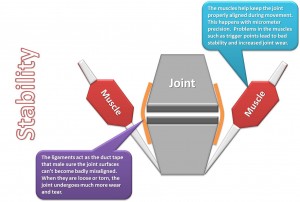How Important is Joint Stability?
How important is joint stability? The answer to that is a stable joint is a happy joint. Yet so many patients come to us with unstable joints that aren’t unstable enough to warrant surgery, but they are unstable enough to fry their joints over time. Understanding instability and how it might impact you is a key component to our Orthopedics 2.0 philosophy. Here’s an infographic on the basic concept. As explained, there are two components to a stable joint: ligaments and muscles. Both have to be working well to allow a stable and healthy joint. Here’s s prior post that explains a very common type of knee instability that we see, a loose ACL ligament and how it can be easily fixed through injection.

If you have questions or comments about this blog post, please email us at [email protected]
NOTE: This blog post provides general information to help the reader better understand regenerative medicine, musculoskeletal health, and related subjects. All content provided in this blog, website, or any linked materials, including text, graphics, images, patient profiles, outcomes, and information, are not intended and should not be considered or used as a substitute for medical advice, diagnosis, or treatment. Please always consult with a professional and certified healthcare provider to discuss if a treatment is right for you.

